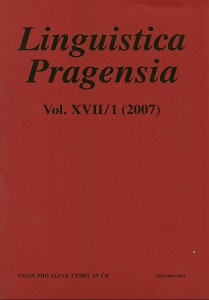IL VERBO ITALIANO DI MODO FINITO ED IL VERBO INGLESE NEL LORO VALORE COMUNICATIVO
ARTICLE: IL VERBO ITALIANO DI MODO FINITO ED IL VERBO INGLESE NEL LORO VALORE COMUNICATIVO
Author(s): Eva KlímováSubject(s): Language and Literature Studies
Published by: AV ČR - Akademie věd České republiky - Ústav pro jazyk český
Summary/Abstract: Eva Klímová: ON THE ITALIAN AND THE ENGLISH FINITE VERB FORM FROM THEIR COMMUNICATIVE VALUE POINT OF VIEW The article deals with the Italian and the English finite verb form observed in their communicative value, i.e. from the functional sentence perspective (FSP) point of view. The Italian inflectional verbal form is confronted with the English finite verb form with the aim of demonstrating their function within the communicative units of the sentence viewed as a communicative field. The Italian finite verb form, expressing all the grammatical categories, may represent several communicative units: the categories of person and number constitute the theme while the categories of tense and mood constitute the transition proper. The notional component of the verb may have the function of transition or rheme. The grammatical and semantic components are included within one verbal form. Thus the Italian finite verb form may participate in several communicative units and reach high communicative value. The communicative value of the English finite verb form, characteristic for poor inflection and tending to loose its lexical meaning, is lower. Both grammatical and non-grammatical components are conveyed by separate elements. The differences observed between Italian and English on the FSP level reflect the morphosyntactic characteristics of both languages.
Journal: Linguistica Pragensia
- Issue Year: 2007
- Issue No: 1
- Page Range: 30-39
- Page Count: 10
- Language: Italian

